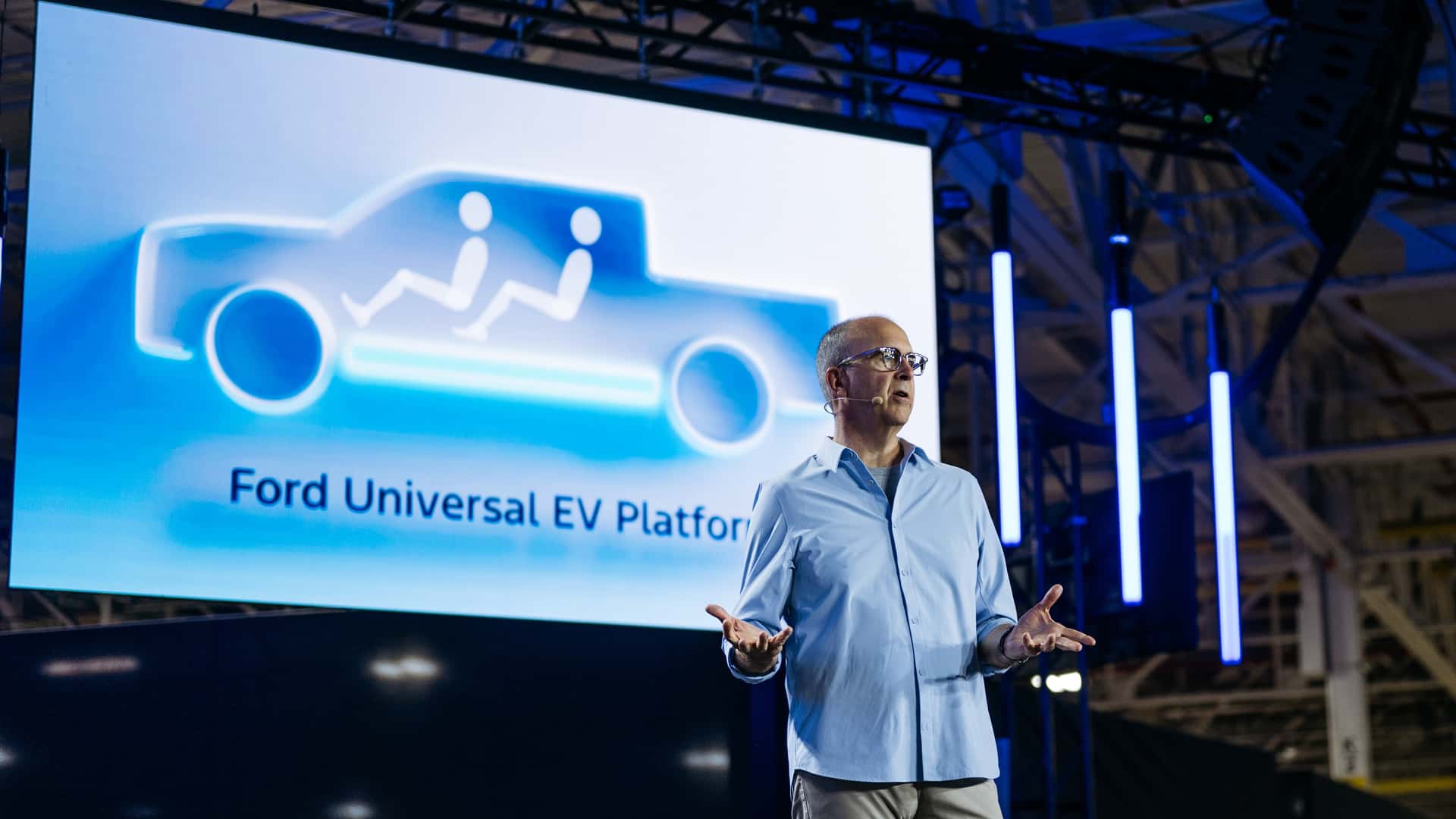
It’s nice to see a brand launch a real effort to get real electric cars onto American roads. Thus far, too many of our electric choices have mostly been either very big, overpriced or a stopgap created to satisfy fuel economy regulations.
Ford CEO Jim Farley said as much during his speech this week at the Louisville, Kentucky plant where Ford will launch a promising $30,000 electric truck: The Ford Universal EV platform will not yield a compliance car.
There’s a lot to like about Ford’s planned new EV, even if we haven’t seen what it’ll look like on the road. For starters, it’s got a right-sized battery that feels like the antithesis to the 200-kWh units found in big General Motors trucks. It’s designed to be made affordably, and with lots of cabin space and a proper frunk. All things that are great to hear. Right?
Uh, I think so. But, I’d be remiss if I didn’t think the way that Ford is going about its new EV platform could be a little risky, just based on what we know from how Ford has executed big ideas in the past.
Canceling a Crossover for a Pickup?
I think that car manufacturers can be a little too up their own asses lately. Like, I think the C-suite execs are all set on building what they want to build, or maybe what’s easy to build, but aren’t necessarily in tune with what people actually are in search of.

The Dodge Charger EV may be the best example of what I’m talking about. Stellantis wanted to build an electric muscle car, despite the fact its clientele didn’t really ever want it. Puzzling still, the conglomerate decided to lead with a two-door car, which I think may have been the biggest kiss of death for Dodge’s EV plans. People don’t like two-door cars; even if the old gas Challenger was plenty popular, the two-door muscle car segment has been sliding for years now. It feels like a severe misstep that Dodge didn’t release the Charger in both two-door and four-door form simultaneously.
Just check Stellantis’s own sales numbers. In 2022, the Charger sedan outsold the two-door Challenger at a roughly three-to-one ratio. You’d think that Stellantis would have remembered that when it decided to lead its new EV products meant to replace traditionally shaped gas-powered models with a relatively niche two-door car. (Let’s face it: The Mustang Mach-E has sold as well as it has in part because it’s a crossover.)

Similarly, I’m confused by Ford’s logic of completely killing two popular crossovers (the Ford Escape and Lincoln Corsair) that play in one of the largest markets in the world—the compact crossover—to replace them with a fully electric pickup truck. I understand the desire for a reasonably priced electric truck, but does Ford really expect that this model will take up the slack for drivers who want a two-row crossover? And would want one powered by gas, no less? Probably not. But we also knew these models were on their way to being done, and Ford’s plans are already in motion, according to Ed Kim, president of automotive market research firm AutoPacific.
“The development of the EV market hasn’t gone as most automakers had planned, and the discontinuing of the Ford Escape and Lincoln Corsair in favor of EV models reflects that,” Kim said in an email. “To be sure, given current events, Ford would no doubt much rather the gasoline-powered Escape and Corsair live on for a few more years, but the unwinding of the supply chains for the manufacturing of those models is likely well underway and it’s almost certainly too late to reverse their cancellation.
"So now, Ford must reckon with the reality that a much lower volume family of affordable EVs will replace two popular and high-volume gasoline-powered nameplates," he added.
Both Kim and I agreed that this still could be a somewhat risky move. Electric pickups just aren’t selling well—the Rivian R1T’s sales are down and Tesla Cybertrucks are piling up, while Ford has scaled back sales goals of its F-150 Lightning more than a few times now. GM has straight-up canceled a plant to produce electric trucks, opting to make big gas-powered pickups instead.

True, Ford’s new platform is said to be modular, and the truck is merely the first vehicle in the series, but given Farley’s comments about not wanting to make a generic two-row crossover, it’s a little concerning that they’re just abandoning such a big part of the auto market. And it’s not even due out until 2027. Can the Mach-E and Bronco Sport really pick up all of the slack until then?
Maybe it’s generic, but I think there are a lot of people who want a two-row, reasonably priced crossover. The whole reason why we created SUVs is because drivers liked the upright and high driving position of a pickup truck, but didn’t want or have a need for the bed. I guess the truck is meant to be “affordable and adaptable,” like the original Ford Model T, but that feels like kind of a stretch. We reached out to Ford to ask why it is leading with a truck, but as of publication the company hasn't gotten back to us.
Generic is okay sometimes. I fear that if Ford doesn’t launch its new truck without a bed-less crossover or sedan follow-up, it could end up like the Dodge Charger EV.
This Ain’t The First Time Ford Has Promised Cheap Green Motoring

Ford’s last foray into alternative-fueled pickup trucks didn’t actually start off smoothly at all. The Maverick and F-150 Lightning are lovely products now, but their launches left a bad taste in a lot of shoppers’ mouths.
Back in 2021, when the F-150 Lightning was announced, Ford made a huge deal out of the fact that it would be $39,999, priced right up against the then recently announced Tesla Cybertruck. It was an instant hit, with Ford saying that it got 200,000 orders within the first few weeks.
Then, right as the truck launched, things faltered. For a multitude of reasons, the sub-$40,000 price never materialized. The base price had marched upward to $60,000, quite a bit higher than what people initially expected. Also, Ford prioritized more expensive builds, sometimes with prices well into the $80,000 range, with no timetable for the base model to ever reach dealer lots. This means that a lot of those 200,000 reservations were subject to price changes and long waits, some of which turned into cancellations.

The Ford Maverick has had a similar trajectory. Ford’s entry-level truck was initially $19,995 for a base model FWD Hybrid with zero options. Like the F-150 Lightning, orders were strong for such a cheap truck with great fuel economy. But like the Lightning, there were price changes, long waits, and relatively few base models ever made. Unfortunately for budget buyers, the Maverick’s prices have only continued to escalate. A base Maverick XL Hybrid is now $30,000, literally $10,000 pricer than when it was first introduced in 2021.
These two things aren’t confidence-inspiring; with that in mind, I can’t help but wonder if Ford’s $30,000 price is legitimate, or just hype? To be fair, Farley was very adamant that this program could go bust: “The automotive industry has a graveyard littered with affordable vehicles that were launched in our country with all good intentions, and they fizzled out with idle plants, laid off workers and red ink,” he said during his speech at Ford’s Kentucky manufacturing plant. But he added: “At Ford three years ago, we set out to break that cycle.” Big talk, so now we’ll see if it can.
Kim has a good point, though. “Given the current prices of EVs, a $30,000 price point for a small but capable pickup with decent range seems impossible, but if Ford’s claims of manufacturing efficiencies really do get the price that low, that would certainly set a new bar for affordability in the industry,” he said.
Maybe things will be different this time.
Contact the author: Kevin.Williams@insideevs.com








